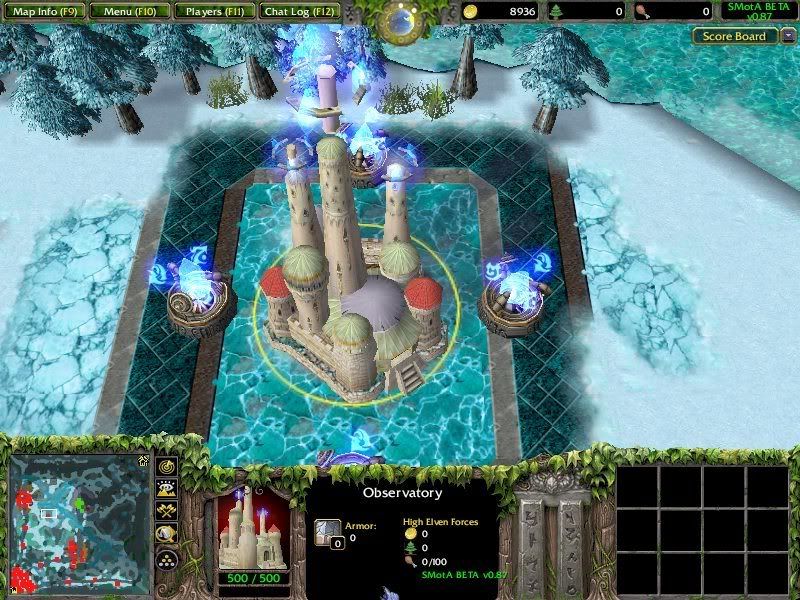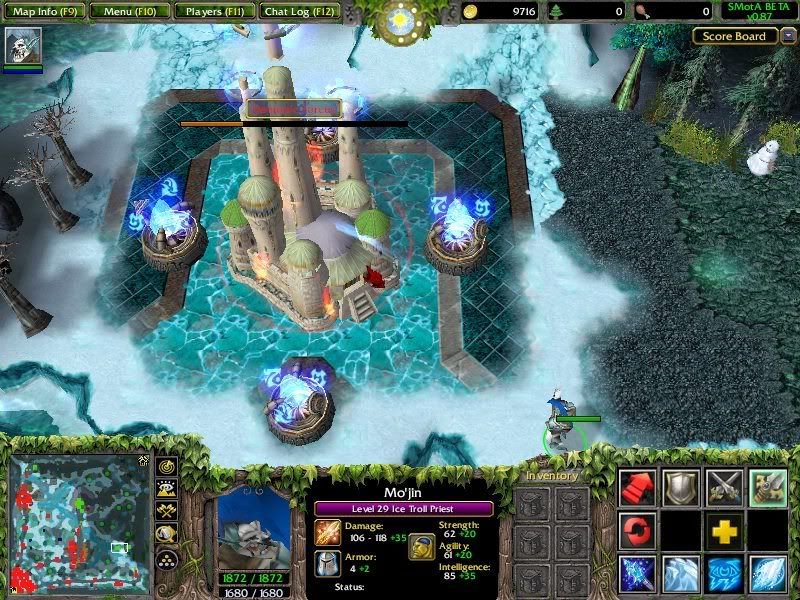Number of Observatories: 2
Observatories per team at the start: 1
Hitpoints: 500
Armor: 0, Fortified
Sight radius: 5000 4000
Truesight radius: 1000
Gold given when captured: 150
HP after capturing: 250 (or 50%)
HP regeneration: 2 per second
Ok, 5000 sight range sounds like a lot. But exactly how much? (In the current version the range is 4000; the pictures below are invalid.)

Note carefully that in the minimap, you can see a large circle of vision where everything around it is dim. That is the sight given by the Observatory!
SMotA has a simple method of capturing Observatories (and Outposts as well, but we will get to that in another section). Simply reduce its hitpoints to zero, and it will switch its allegiance! However, it is possible to deny them; when you land the final blow on your team's Observatory, it will remain under your team's control.

After capturing an Observatory, it will be reset to half-hp and begin self-repairing from there. This is to make captures in the early game not take so long; at the same time, some heroes with certain abilities will be able to take out a freshly captured Observatory in one hit, making them very difficult to defend.

Tips
The point of Observatories is to give the controlling team much enhanced sight, and also to give the map even more of a "territorial" feel, especially combined with the Outposts. The team controlling the nearby Observatory can easily set up ganks, and just as easily avoid them. They can also serve as a fighting ground against invisibility heroes, since Observatories do have a 1000 aoe Truesight. However, many of these invisibility heroes can simply capture the Observatory themselves and use it against you!
Observatory Rush
A common strategy by advanced players is the Observatory Rush. As the name suggests, the player will pick a hero, buy some starting items, then immediately use one of the Teleporters and head for the enemy Observatory with the idea of capturing it before the first creep wave. Heroes with a summon at level one, e.g. Skink, Druid of the Talon, etc., can use their summon to help bring down the Observatory's hitpoints. If the opponent's team is caught off-guard with all of their heroes still in the base, then the Observatory can usually be taken.
However, in the case where a hero or two are sent to defend, a battle can occur as early as level one, usually to the victory of the defenders. But sometimes the offense sends in two, three, or even five heroes to get the Observatory, then scramble to their lanes. The defensive side normally has to concede the Observatory for at least the first five minutes of the game, because if a hero goes to recapture it, they will be losing out on precious experience in the lane (newbies often fall for this trick). This early attack guarantees a sight advantage and also a slight monetary one, since the player who last-hit the Observatory will have 150 extra gold!
In fact, if the attack occurs extremely early, and the other team does not defend, one hero can go in, capture the Observatory, run back to a Teleporter, buy an item with the extra gold, then teleport back in the lane just in time for the first creep wave to meet. However the player has to be really quick and know where the Teleporters are in order to pull this off.
Summoned Units
A number of heroes can summon attacking units, normally to assist in combat. However, most summons are also great for capturing Observatories, especially in the early game, since the hero can stay in the lane farming experience, while the summoned unit engages in a one-sided battle against an Observatory. The downside is that because summons are generally much weaker than heroes, a defending hero can normally defend the Observatory from capture. But that also means you can have more experience from farming in your lane. In the late game, summons can be put to better use since the hero should be able to run quickly with Boots to the Observatory, take it down in a few hits, then run back to the lane with 150 extra gold.
Observatory vs. Outpost
Often in the heat of the middle and late game, players have to make short term decisions on whether to capture a certain Outpost or an Observatory. My suggestion is if you can, take both. And if you can't, it is often a choice in which the correct action depends on the situation. Observatories have less hitpoints and are undefended, but are further from Teleporter exits. So if you think there are nearby enemies, go for the Observatory, since immediately after capturing it you will be able to see anyone nearby. Taking an Outpost has a larger impact on the game, but if a hero shows up and forces a fight in front of his Outpost tower, then you are at a disadvantage.
Neutrals
Both Observatories are within walking distance of neutral creep camps, which provide excellent farming opportunities. The bad news is that while farming, your outpost may be captured and the enemy will know exactly where you are. However, the good news is that you will be able to see him coming from a mile away before he even gets near the Observatory.
No comments:
Post a Comment